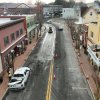Two scientists question sea-level rise, but we face problems no matter what
Two Delaware organizations, Positive Growth Alliance and the Caesar Rodney Institute, held a meeting in Georgetown last week featuring two scientists who are skeptical about sea-level rise.
Both scientists appear to have good credentials. One, Willie Soon, is a researcher at the Harvard-Smithsonian Center for Astrophysics. The other, David Legates, is a former state climatologist for Delaware.
They say that predictions for sea-level rise are based on bad science. The PGA, which is dedicated to preserving property rights, quite naturally uses its statements to argue that state policies and land-use decisions shouldn’t be based on these predictions.
There’s a lot of information online outlining the grants Soon has received from, among others, the Exxon Foundation, the Mobil Foundation and the Charles G. Koch Foundation, all organizations with strong incentive to deny climate change and sea level rise. There’s also a website, Skeptical Science, that looks at the claims of climate-change deniers.
But my point here isn’t to weigh the merits of each side’s case, though it needs to be mentioned that the scientific community overwhelmingly supports the view that climate change is real. (If you don’t believe the scientists, perhaps you’d believe the insurance companies, which, increasingly, are pulling back from writing policies for coastal homeowners. Why would profit-driven insurance companies refuse business without good reason?)
My real point is: So what?
For the people living along Delaware’s coast - and really for all Delaware taxpayers - it doesn’t matter what Soon or Legates or anyone else says. Or what exactly is causing the change. We can see for ourselves that Delaware’s coastline is receding.
People who grew up here can recall when North Shore’s World War II towers were set far back from the shoreline. Newcomers can drive up to Fowler Beach and see what used to be a land-based structure, now surrounded by water. (But I wouldn’t recommend driving there during a nor’easter; the roads might be flooded.)
Communities from Wilmington on down through the Kent and Sussex beach towns and over to the Inland Bays area face flooding issues. We can’t afford to waste too much time arguing why.
One of the peculiar things about climate-change deniers is how often they play the victim card: No one listens to our side, they complain. The opposite is true. The meeting in Georgetown was well attended and received respectful coverage in both this paper and the statewide daily.
If sea-level rise isn’t to be considered when making land-use decisions, how about for state building projects, such as the still-new $150 million Indian River Inlet bridge?
It’s a beautiful bridge, but already it’s facing problems. The state had to add a steel wall to protect roadway foundations. After the recent nor’easter, which closed the bridge for the second time in six months, DelDOT Secretary Shailen Bhatt was quoted saying, “There will be more storms and with the awesome power of the ocean there is only so much we can do.”
Exactly. There is only so much we can do. We can’t hold back the tides or prevent storms. But we can deal with the situation as it is and not how we want it to be. If the state were to consider new projects in coastal Delaware, most taxpayers would expect it would take seriously the opinion of the vast majority of scientists who think sea levels are rising and build - or not build - accordingly.
Eventually, the same will be true of land-use decisions. Governments will have to take the retreating coastline into account when considering development.
The alternative - if you can call it that - is to simply disregard the best available scientific research.
When people ignore the obvious, it’s common to say they’re sticking their heads in the sand. In Delaware, where we’re losing so much sand, it might be more fitting to say they’re sticking their heads underwater.
It was the AR-15
This has become something of a moot point - at least nationally - as Congress has decided against including a ban on military-style rifles in any gun bill, but I wanted to correct comments I’ve been getting locally: Namely, that the Newtown, Conn., massacre was carried out with handguns, not the Bushmaster AR-15 rifle.
According to the Connecticut State Police - and this information can be easily looked up - all 26 victims were shot with a Bushmaster AR-15 rifle. If anybody has a better source that says otherwise, please contact me.


















































